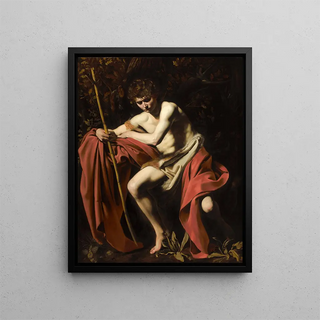Art print | Saint John the Baptist in the Wilderness - Caravaggio


View from behind

Frame (optional)
Saint John the Baptist in the Wilderness - Caravaggio – Captivating Introduction
In the world of art, certain works transcend time and space, captivating the eye and awakening emotions. "Saint John the Baptist in the Wilderness" by Caravaggio is undoubtedly one of these iconic pieces. Painted at the end of the 16th century, it embodies both spiritual depth and technical mastery of its creator, offering a fascinating glimpse into life and faith during a pivotal period in art history. The depiction of the saint, isolated in the wild nature, evokes deep introspection, a quest for truth that still resonates today. This canvas, both powerful and contemplative, transports us into a universe where light and shadow engage in a fascinating dialogue, revealing the complexity of the human soul.
Style and uniqueness of the work
Caravaggio's style is immediately recognizable, characterized by his bold use of chiaroscuro. In "Saint John the Baptist in the Wilderness," this technique is executed with exceptional virtuosity. The light, emanating from an invisible source, illuminates the face and body of the saint, creating a striking contrast with the surrounding darkness. This play of light not only emphasizes John the Baptist's expression but also highlights the textures of the skin and natural elements around him. The composition is both dynamic and balanced, with each element carefully placed to guide the viewer's gaze. The saint's posture, both relaxed and meditative, invites reflection on solitude and devotion. This painting does not merely depict a frozen moment in time; it evokes a palpable spiritual atmosphere, where every detail seems charged with meaning.
The artist and his influence
Michelangelo Merisi da Caravaggio, known simply as Caravaggio, is a central figure of Baroque painting. His tumultuous life and revolutionary approach to artistic representation marked a turning point in art history. By choosing to depict religious subjects with raw realism and palpable emotion, he paved the way for a new way of seeing and understanding art. Caravaggio influenced many artists, both of

Matte finish

View from behind

Frame (optional)
Saint John the Baptist in the Wilderness - Caravaggio – Captivating Introduction
In the world of art, certain works transcend time and space, captivating the eye and awakening emotions. "Saint John the Baptist in the Wilderness" by Caravaggio is undoubtedly one of these iconic pieces. Painted at the end of the 16th century, it embodies both spiritual depth and technical mastery of its creator, offering a fascinating glimpse into life and faith during a pivotal period in art history. The depiction of the saint, isolated in the wild nature, evokes deep introspection, a quest for truth that still resonates today. This canvas, both powerful and contemplative, transports us into a universe where light and shadow engage in a fascinating dialogue, revealing the complexity of the human soul.
Style and uniqueness of the work
Caravaggio's style is immediately recognizable, characterized by his bold use of chiaroscuro. In "Saint John the Baptist in the Wilderness," this technique is executed with exceptional virtuosity. The light, emanating from an invisible source, illuminates the face and body of the saint, creating a striking contrast with the surrounding darkness. This play of light not only emphasizes John the Baptist's expression but also highlights the textures of the skin and natural elements around him. The composition is both dynamic and balanced, with each element carefully placed to guide the viewer's gaze. The saint's posture, both relaxed and meditative, invites reflection on solitude and devotion. This painting does not merely depict a frozen moment in time; it evokes a palpable spiritual atmosphere, where every detail seems charged with meaning.
The artist and his influence
Michelangelo Merisi da Caravaggio, known simply as Caravaggio, is a central figure of Baroque painting. His tumultuous life and revolutionary approach to artistic representation marked a turning point in art history. By choosing to depict religious subjects with raw realism and palpable emotion, he paved the way for a new way of seeing and understanding art. Caravaggio influenced many artists, both of






